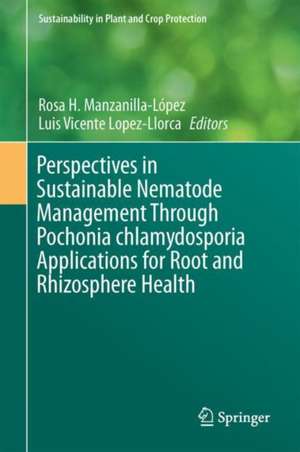Perspectives in Sustainable Nematode Management Through Pochonia chlamydosporia Applications for Root and Rhizosphere Health: Sustainability in Plant and Crop Protection
Editat de Rosa H. Manzanilla-López, Luis V. Lopez-Llorcaen Limba Engleză Hardback – 17 oct 2017
| Toate formatele și edițiile | Preț | Express |
|---|---|---|
| Paperback (1) | 794.13 lei 38-44 zile | |
| Springer International Publishing – 22 aug 2018 | 794.13 lei 38-44 zile | |
| Hardback (1) | 810.45 lei 38-44 zile | |
| Springer International Publishing – 17 oct 2017 | 810.45 lei 38-44 zile |
Din seria Sustainability in Plant and Crop Protection
- 18%
 Preț: 1244.08 lei
Preț: 1244.08 lei - 24%
 Preț: 794.96 lei
Preț: 794.96 lei - 18%
 Preț: 1126.59 lei
Preț: 1126.59 lei - 15%
 Preț: 648.24 lei
Preț: 648.24 lei - 24%
 Preț: 781.64 lei
Preț: 781.64 lei - 18%
 Preț: 1107.56 lei
Preț: 1107.56 lei - 24%
 Preț: 818.76 lei
Preț: 818.76 lei - 24%
 Preț: 1053.51 lei
Preț: 1053.51 lei - 24%
 Preț: 792.90 lei
Preț: 792.90 lei - 20%
 Preț: 558.51 lei
Preț: 558.51 lei - 23%
 Preț: 579.82 lei
Preț: 579.82 lei - 24%
 Preț: 835.82 lei
Preț: 835.82 lei - 18%
 Preț: 944.67 lei
Preț: 944.67 lei - 18%
 Preț: 1380.98 lei
Preț: 1380.98 lei - 18%
 Preț: 951.91 lei
Preț: 951.91 lei - 18%
 Preț: 1229.28 lei
Preț: 1229.28 lei
Preț: 810.45 lei
Preț vechi: 1066.38 lei
-24% Nou
Puncte Express: 1216
Preț estimativ în valută:
155.12€ • 159.86$ • 130.96£
155.12€ • 159.86$ • 130.96£
Carte tipărită la comandă
Livrare economică 25 februarie-03 martie
Preluare comenzi: 021 569.72.76
Specificații
ISBN-13: 9783319592220
ISBN-10: 331959222X
Pagini: 421
Ilustrații: XXV, 411 p. 69 illus., 42 illus. in color.
Dimensiuni: 155 x 235 x 27 mm
Greutate: 0.86 kg
Ediția:1st ed. 2017
Editura: Springer International Publishing
Colecția Springer
Seria Sustainability in Plant and Crop Protection
Locul publicării:Cham, Switzerland
ISBN-10: 331959222X
Pagini: 421
Ilustrații: XXV, 411 p. 69 illus., 42 illus. in color.
Dimensiuni: 155 x 235 x 27 mm
Greutate: 0.86 kg
Ediția:1st ed. 2017
Editura: Springer International Publishing
Colecția Springer
Seria Sustainability in Plant and Crop Protection
Locul publicării:Cham, Switzerland
Cuprins
Section I: Introduction and Systematics .- Chapter 1 Introduction (Historical and Overview).- Chapter 2 Systematics of Pochonia .- Section II: Bionomics.- Chapter 3 Biology and Management of Pochonia chlamydosporia and Plant-parasitic Nematodes.- Chapter 4: Interactions between Pochonia chlamydosporia and Nematodes.- Section III: -Omics and other Approaches.- Chapter 5 Regulatory Factors in Pochonia chlamydosporia-Induced Gene Expression.- Chapter 6 Proteomics.- Chapter 7 Secondary metabolites from Pochonia chlamydosporia and other species of Pochonia.- Chapter 8 Metabolomics.- Chapter 9 Comparative Analysis of Pochonia chlamydosporia Mitogenome Reveals Dynamic Mitochondrial Evolution of the Nematophagous Fungi in Hypocreales.- Chapter 10 Pochonia chlamydosporia: Multitrophic Lifestyles Explained by a Versatile Genome.- Section IV: Methodology.- Chapter 11 Methodology Part I. Pochonia spp. in vitro Culturing: Media, Strain Maintenance and Deposition.- Chapter 12 Methodology Part II. Pochonia spp.: Screening and Isolate Selection for Managing Plant-parasitic Nematodes.- Chapter 13 Molecular Diagnostics of Pochonia chlamydosporia.- Section V: Practical Approaches and Management Studies.- Chapter 14 Priming Plant Defence Responses can Enhance the Biological Control of Pochonia chlamydosporia Against Root-knot Nematodes.- Chapter 15 Pochonia chlamydosporia Microbial Products to Manage Plant-parasitic Nematodes: Case Studies from Cuba, Mexico and Brazil.- Chapter 16 Management Strategies: Pochonia chlamydosporia and IPM of Plant-parasitic nematodes in Temperate Crops.- Chapter 17 Pochonia chlamydosporia: A Promising Biotechnological Tool Against Parasitic Nematodes and Geohelminths.- Section VI: Future Perspectives.- Chapter 18 Future Perspectives.
Recenzii
“This book presents the work of researchers around the world from the first years until the new age of -omics research and is an excellent source for students and professionals interested in the potential of P. chlamydosporia.” (Sebastian Kiewnick, Nematology, Vol. 20 (5), 2018)
Textul de pe ultima copertă
Pochonia chlamydosporia, a cosmopolitan fungus occurring in soils as a saprophyte yet capable of colonizing the rhizosphere of crops as an endophyte and behaving as a parasite of eggs of plant-parasitic nematodes, has been the subject of great interest largely because of its potential as a biological control agent of cyst and root-knot nematodes. This volume reviews the current knowledge available on the fungus. The book is divided into six sections containing 18 chapters, starting with a historical background chapter, followed by 16 chapters, each contributed by experts, concerning those key aspects necessary to work with this biocontrol agent in a multidisciplinary treatise. Topics covered include systematics, biology, nematode-fungus interactions, nematode management strategies, secondary metabolites, and other methods including more novel research areas such as molecular, –omics, plant growth enhancement and endophytic abilities of P. chlamydosporia. The final chapter deals with the future perspectives of P. chlamydosporia research.The book is aimed at researchers, professionals, practitioners, and graduate or undergraduate students involved in both basic and applied studies, as well as in activities dealing with biocontrol agents of plant-parasitic nematodes, helminths, crop protection and integrated pest management. It concentrates on fundamental aspects, and the evolution, of nematophagous fungi.
Caracteristici
This book is a multidisciplinary treatise with contributions by experts presented in a single volume and concerning the biology, physiology, ecology, protocols for production, integrated pest management strategies compatibility with Pochonia chlamydosporia, and other practical aspects of P. chlamydosporia use There is a growing interest in the biopesticides market on products based on Pochonia chlamydosporia formulations. This volume covers those key aspects necessary to work with this biocontrol agent. The potential use of the fungus, not only as biological control agent but as a plant growth promoter and biofertilizer, will help to diversify the application of the fungus in crop management The phasing-out of methyl bromide and nematicides has intensified the search for chemical or biological alternatives to maintain crop production under more strict policies to control pests and diseases using innovative environmentally friendly approaches for which Pochonia chlamydosporia is capable of playing an important role
